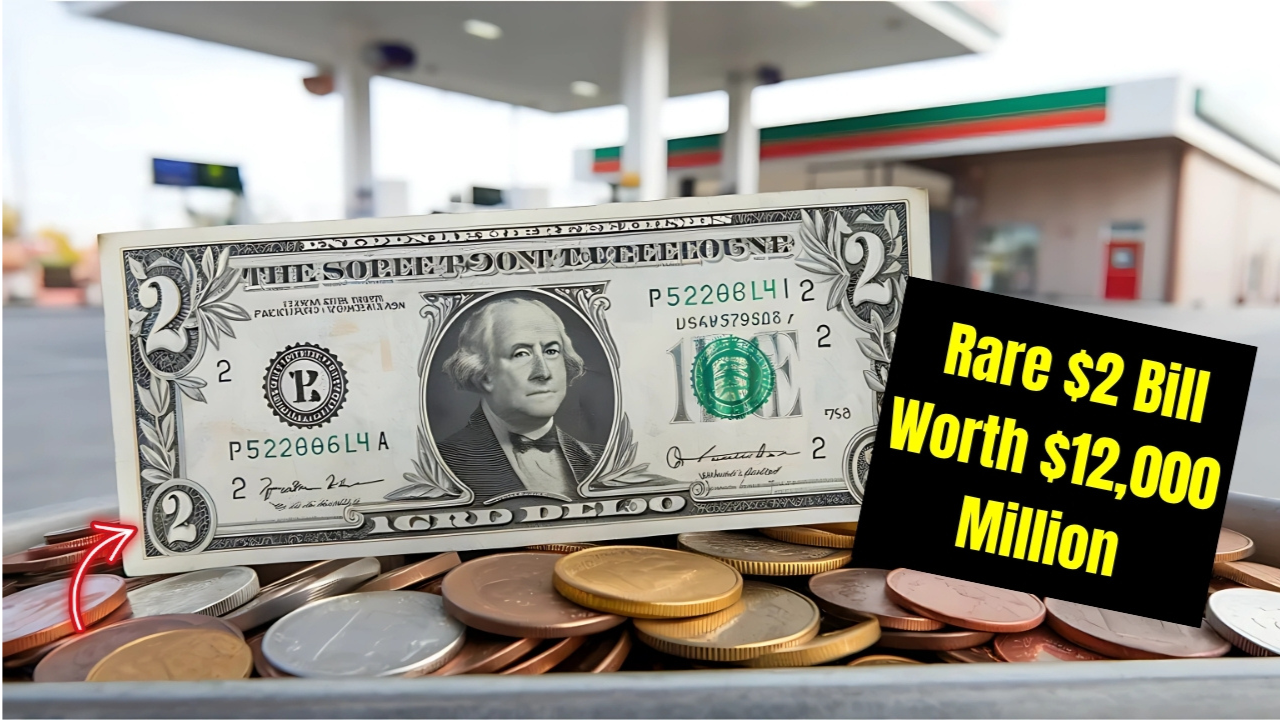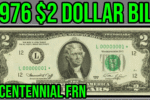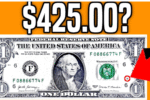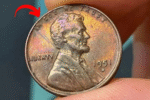This $10 Note Found in Everyday Change Sold For $39,000:In the digital age, when most transactions happen with a swipe or tap, physical currency can seem like a relic of the past. Still, sometimes the most extraordinary finds are hidden in plain sight. That’s what happened when an ordinary-looking 2021 series $10 note used in everyday transactions turned out to be worth nearly $40,000 thanks to a rare printing error that escaped modern quality control.
Imagine this: You’re making your regular deposit at the bank, handling crisp bills without much thought, when something catches your eye. The printing on one of the ten dollar bills looks… fishy. There’s a subtle doubling, a ghost-like shadow where crisp, clean lines should be. Most people might dismiss it as wear, but for an observant person, this moment of curiosity could prove worth thousands of dollars.
The 2021 $10 note didn’t look dramatically different at first glance. Alexander Hamilton’s portrait still gazed solemnly from the front, and the Treasury building remained stately on the back. Upon closer examination, however, the telltale signs of a double printing error became apparent – light repetition in the background pattern, subtle misalignments in shading, and the kind of ghosting effect that currency experts dream of finding.
Understanding the Phenomenon of Double-Printing
To understand why this particular error is so valuable, we need to understand how modern currency production works. The Bureau of Engraving and Printing operates with such precision that Swiss watchmakers would envy. Numerous security features, advanced printing techniques, and rigorous quality control measures ensure that nearly every note meets exacting standards before it goes into circulation.
A double-printing error occurs when a sheet of currency accidentally passes through the printing press more than once. This can happen during different stages of the production process, but with modern security measures, such errors are incredibly rare. This results in overlapping images, duplicate design elements, or offset printing that creates the distinctive “ghosting” effect seen on error notes.
What makes the 2021 $10 note special is that it shows the failure of multiple quality control systems. Each sheet of currency is inspected at various stages, yet this particular error somehow went undetected. The rarity of such modern errors, combined with the advanced security features of contemporary bills, makes them many times more valuable than similar errors from previous decades.
The Journey from Pocket to Auction House
The path from discovery to sale is akin to a modern treasure hunt. After the initial discovery during a bank deposit, the note’s unusual appearance caught the attention of someone familiar with currency collecting. Recognizing the potential significance of the printing anomaly, he sought professional authentication.
Currency grading is a specialized field that requires extensive expertise. Professional grading services such as Paper Money Guaranty (PMG) and Professional Coin Grading Service (PCGS) Currency employ experts who can distinguish between genuine errors and damaged bills, counterfeit attempts, or post-production alterations. The authentication process involves detailed examination under special lighting, measurement of printing registration, and comparison with known error types.
This particular $10 note received grades indicating “nearly obsolete” to “obsolete” condition, meaning it shows minimal handling despite having circulated. The combination of the rare error and excellent condition created the perfect storm for collector interest.
When the bill arrived at auction, currency collectors and error-note experts immediately recognized its significance. Bidding was aggressive, reflecting both the rarity of modern printing errors and the growing interest in contemporary numismatic pieces. The final hammer price of $39,000 represented a return of over 3,900 times the bill’s face value.
The Economics of Error Currency
The $39,000 selling price may seem astronomical for a ten dollar bill, but it reflects several economic factors unique to error currency collecting. Scarcity determines a large portion of the value – printing errors are incredibly rare with modern quality control, with each verified error note representing a singular moment when multiple systems failed simultaneously.
Condition plays a significant role in pricing. Currency that has been in circulation typically shows wear, folds, or stains that can significantly impact value. Finding an error note in pristine condition is like discovering a perfect diamond in rough terrain. The fact that this bill maintained its structural integrity throughout circulation makes it even more remarkable.
The market demand for modern error currency continues to grow. While traditional currency collecting often focuses on historic notes from the 19th and early 20th centuries, a new generation of collectors appreciates the technical precision required to create modern errors. The complexity of contemporary security features makes any production failure more scientifically interesting and aesthetically appealing.
Comparable sales support the $39,000 valuation. Similar modern flawed notes have fetched even higher prices at recent auctions, with some double-printed notes selling for hundreds of thousands of dollars. The difference in price often depends on the dramatic nature of the error, the denomination involved, and the overall condition of the note.
Recognizing Error Currency in the Wild
For those motivated to look for their wallet, understanding what to look for can mean the difference between spending a fortune and earning a fortune. Double-printing errors manifest in a variety of ways, each creating distinctive visual cues to the trained eye.
The most obvious signs include ghosting or shadow effects where design elements appear lightly duplicated. This can appear as double serial numbers, overlapping seals, or background patterns that appear to be a slightly offset shadow version of the main image. Sometimes the doubling is so subtle that it requires careful examination in good light to detect.
Misalignment represents another category of printing errors. When sheets shift between printing passes, the result can be design elements that don’t line up properly. You might see portraits that appear slightly off center, borders that don’t align with the edges of the paper, or text that appears to float away from where it should be placed.
Color variations can also indicate printing problems. If the ink doesn’t register properly after multiple passes, you may see areas where colors appear darker or lighter than normal, or where different ink colors blend into each other in unexpected ways.
The series year matters when evaluating potential errors. Modern bills like the 2021 series incorporate advanced security features and undergo more rigorous quality control than older currency. This makes any errors far more rare and valuable than similar mistakes from previous decades.
The Science Behind Modern Currency Production
To understand why modern errors are so valuable, it is helpful to appreciate the technical sophistication of contemporary currency production. The Bureau of Engraving and Printing uses offset printing presses that apply multiple ink colors in precise sequence, each requiring perfect registration to create the final product.
Security features add layers of complexity to the printing process. Microprinting, color-changing inks, watermarks, security threads and other anti-counterfeiting measures must all align perfectly. Each additional security element represents another opportunity for error—and another quality control checkpoint that must fail for a mistake to reach circulation.
Digital inspection systems scan each note for defects using high-resolution cameras and computer analysis to detect deviations from specifications. These systems can identify problems invisible to the human eye, making any error that escapes detection from a technical perspective noteworthy.
The paper itself undergoes special treatments, including the addition of protective fibers and a special cotton-linen blend composition. This substrate must maintain consistency throughout the printing process, and any changes to it can affect the way inks adhere or the alignment of multiple printing passes.
Investment Potential and Market Trends
Currency collecting represents a unique intersection of history, art, and investment potential. Error notes hold a special place within this market, offering the excitement of discovery as well as significant appreciation potential.
Historical data shows that rare error currency has generally outperformed traditional investment instruments over the long term. However, like any collectibles market, currency values can fluctuate based on collector interest, economic conditions, and the search for similar pieces.
The modern error market benefits from several favorable trends. Digital photography and online auction platforms have made it easier for collectors to share finds and verify authenticity. Social media has helped build communities around currency collecting, introducing new participants to the hobby.
Authentication technology continues to improve, giving collectors more confidence in their purchases. Third-party grading services provide standardized evaluation criteria, creating more liquid markets for high-value pieces.
The limited supply of modern errors creates favorable long-term dynamics. Unlike historical currency, where the discovery of an occasional hoarded note can flood the market, modern errors can only be created during active production periods. Once quality control systems improve or note designs change, certain types of errors become impossible to recreate.
Professional authentication and grading
The difference between a valuable error note and a costly mistake often depends on professional authentication. Reputable grading services employ experts who understand the subtle differences between genuine errors, post-production damage and attempted alterations.
The authentication process begins with detailed photography under special lighting that can reveal changes invisible under normal conditions. Examiners look for signs of tampering, artificial aging or attempts to create fake errors through chemical or mechanical means.
Microscopic examination reveals printing characteristics that help verify authenticity. Genuine printing errors show distinctive patterns in ink deposition, paper fiber alignment and registration marks that are difficult to replicate artificially.
Paper analysis can confirm that the substrate matches Bureau of Engraving and Printing specifications. Counterfeiters often struggle to replicate the exact paper composition, security fiber placement and texture of genuine currency.
Once authenticated, grading services assign condition scores based on standardized criteria. These grades consider factors such as centering, corners, edges, and surface quality. Higher grades command much higher prices, making professional appraisal necessary for valuable items.
The Future of Erroneous Currency Collecting
As production technology continues to advance, the nature of currency errors is also likely to change. New security features create new opportunities for mistakes, while improved quality control makes any errors much less likely.
The adoption of digital payments indirectly affects the physical currency market. As fewer bills are in circulation, the likelihood of discovering errors in everyday transactions decreases. However, this reduction may actually increase the values of those flawed notes that do come to light.
International interest in U.S. currency errors is growing, expanding the potential market for exceptional pieces. Online auction platforms make it easier for global collectors to participate in the market, potentially driving up prices for the most desired items.
Technology may also create new categories of errors as security features become more sophisticated. Holographic elements, embedded chips or other advanced anti-counterfeiting measures could produce errors that do not exist today.
Beyond the headlines: What this discovery means
The $39,000 ten-dollar bill is more than just a lucky find. It shows that even in our increasingly digital world, physical currency continues to have its allure and value. The note serves as a reminder that extraordinary discoveries can still happen under normal circumstances.
For currency collectors, this discovery proves the importance of careful investigation and professional authentication. It shows that modern errors can fetch prices equal to historical rarities, fueling continued interest in contemporary currency.
The story also highlights the role of coincidence in collecting. Unlike targeted searches for specific historical items, error currency discoveries often rely on being in the right place at the right time and a trained eye to recognize something unusual.
Magic hidden in plain sight
In a world where digital transactions dominate and physical currency is rapidly becoming obsolete, the discovery of a $39,000 ten dollar bill reminds us that magic can still be hidden in plain sight. This remarkable find represents the intersection of manufacturing precision and human error, creating something out of the ordinary.
The story of this extraordinary $10 note will likely inspire countless people to examine their currency more carefully, hoping to find a coin collecting treasure of their own. While such discoveries are incredibly rare, the possibility that there may still be something of extraordinary value in someone’s wallet adds to the excitement that makes currency collecting such a fascinating hobby.
Whether you’re a seasoned collector or someone who’s just learned about flawed currency, remember that the next note you handle may be worth more than it appears. In the age of digital everything, sometimes the most valuable discoveries are still made through careful observation and a willingness to take a second look at something that seems the slightest bit out of place.
The lesson from this remarkable ten-dollar bill worth $39,000 is simple: in a world full of mass-produced perfection, imperfection itself becomes highly valuable.





